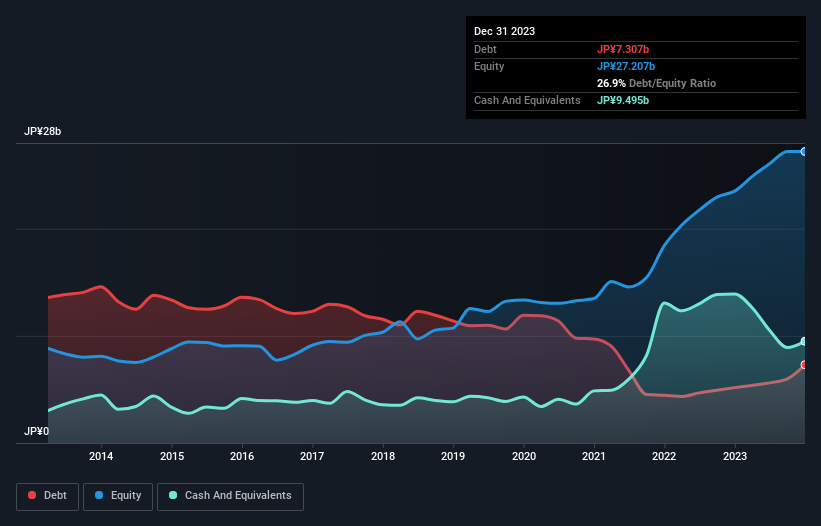
Howard Marks put it nicely when he said that, rather than worrying about share price volatility, 'The possibility of permanent loss is the risk I worry about... and every practical investor I know worries about.' It's only natural to consider a company's balance sheet when you examine how risky it is, since debt is often involved when a business collapses. As with many other companies Okamoto Machine Tool Works, Ltd. (TSE:6125) makes use of debt. But is this debt a concern to shareholders?
Why Does Debt Bring Risk?
Debt is a tool to help businesses grow, but if a business is incapable of paying off its lenders, then it exists at their mercy. Ultimately, if the company can't fulfill its legal obligations to repay debt, shareholders could walk away with nothing. However, a more common (but still painful) scenario is that it has to raise new equity capital at a low price, thus permanently diluting shareholders. By replacing dilution, though, debt can be an extremely good tool for businesses that need capital to invest in growth at high rates of return. The first step when considering a company's debt levels is to consider its cash and debt together.
View our latest analysis for Okamoto Machine Tool Works
How Much Debt Does Okamoto Machine Tool Works Carry?
The image below, which you can click on for greater detail, shows that at December 2023 Okamoto Machine Tool Works had debt of JP¥7.31b, up from JP¥5.17b in one year. However, it does have JP¥9.50b in cash offsetting this, leading to net cash of JP¥2.19b.

How Healthy Is Okamoto Machine Tool Works' Balance Sheet?
We can see from the most recent balance sheet that Okamoto Machine Tool Works had liabilities of JP¥24.1b falling due within a year, and liabilities of JP¥4.66b due beyond that. Offsetting this, it had JP¥9.50b in cash and JP¥9.05b in receivables that were due within 12 months. So it has liabilities totalling JP¥10.2b more than its cash and near-term receivables, combined.
While this might seem like a lot, it is not so bad since Okamoto Machine Tool Works has a market capitalization of JP¥29.8b, and so it could probably strengthen its balance sheet by raising capital if it needed to. But it's clear that we should definitely closely examine whether it can manage its debt without dilution. Despite its noteworthy liabilities, Okamoto Machine Tool Works boasts net cash, so it's fair to say it does not have a heavy debt load!
On the other hand, Okamoto Machine Tool Works saw its EBIT drop by 9.9% in the last twelve months. That sort of decline, if sustained, will obviously make debt harder to handle. When analysing debt levels, the balance sheet is the obvious place to start. But you can't view debt in total isolation; since Okamoto Machine Tool Works will need earnings to service that debt. So if you're keen to discover more about its earnings, it might be worth checking out this graph of its long term earnings trend.
Finally, a company can only pay off debt with cold hard cash, not accounting profits. Okamoto Machine Tool Works may have net cash on the balance sheet, but it is still interesting to look at how well the business converts its earnings before interest and tax (EBIT) to free cash flow, because that will influence both its need for, and its capacity to manage debt. Looking at the most recent three years, Okamoto Machine Tool Works recorded free cash flow of 46% of its EBIT, which is weaker than we'd expect. That weak cash conversion makes it more difficult to handle indebtedness.
Summing Up
Although Okamoto Machine Tool Works's balance sheet isn't particularly strong, due to the total liabilities, it is clearly positive to see that it has net cash of JP¥2.19b. So we don't have any problem with Okamoto Machine Tool Works's use of debt. When analysing debt levels, the balance sheet is the obvious place to start. However, not all investment risk resides within the balance sheet - far from it. Case in point: We've spotted 1 warning sign for Okamoto Machine Tool Works you should be aware of.
At the end of the day, it's often better to focus on companies that are free from net debt. You can access our special list of such companies (all with a track record of profit growth). It's free.
New: AI Stock Screener & Alerts
Our new AI Stock Screener scans the market every day to uncover opportunities.
• Dividend Powerhouses (3%+ Yield)
• Undervalued Small Caps with Insider Buying
• High growth Tech and AI Companies
Or build your own from over 50 metrics.
Have feedback on this article? Concerned about the content? Get in touch with us directly. Alternatively, email editorial-team (at) simplywallst.com.
This article by Simply Wall St is general in nature. We provide commentary based on historical data and analyst forecasts only using an unbiased methodology and our articles are not intended to be financial advice. It does not constitute a recommendation to buy or sell any stock, and does not take account of your objectives, or your financial situation. We aim to bring you long-term focused analysis driven by fundamental data. Note that our analysis may not factor in the latest price-sensitive company announcements or qualitative material. Simply Wall St has no position in any stocks mentioned.
About TSE:6125
Okamoto Machine Tool Works
Manufactures and sells grinding machines, semiconductor, gear, and casting equipment in Japan and internationally.
Excellent balance sheet average dividend payer.
Market Insights
Community Narratives



